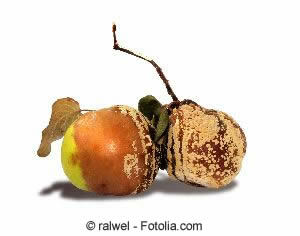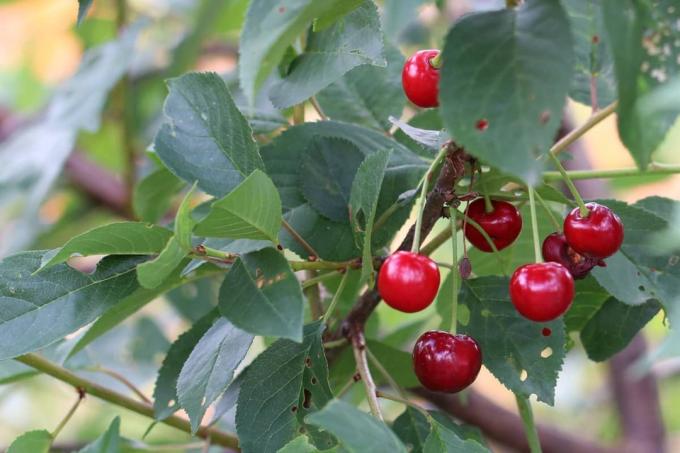

Table of contents
- June fruit fall
- Premature leaf fall
- Pour
- fertilization
- waste
- leaf fall disease
- fruit tree spider mite
- apple scab
- loss of fruit
- codling moth
- Conclusion
As a puree, cake or simply fresh - freshly harvested apples from our own garden are a real treat. All the more annoying when the fruit falls off the tree prematurely. However, that alone is no reason to worry. The loss of leaves and fruit, on the other hand, does. In such cases, it is important to find out quickly what is causing the apple tree to wilt prematurely. Otherwise, it is usually not just a harvest that is at risk, but the entire crop.
June fruit fall
The summery and thus premature fall of some fruits is by no means a cause for concern. Instead, it is a completely natural and sensible process, especially in years with high yields. During the so-called June fruit drop, the apple tree sheds all those fruits that are insufficiently fertilized, underdeveloped or simply superfluous. In this way, the crop ensures that it does not overstrain and overstrain itself in the care and ripening of the apples. Or even damage to the apple tree caused by the weight of the fruit. So a large amount of fallen fruit in summer is not alarming. However, the fruits of the apple tree should be checked directly when they are picked up. If these show signs of being eaten, wormholes, rotting of the stalks, extreme discoloration or coverings, the leaves of the apple tree should also be examined carefully for any symptoms of the disease.
Premature leaf fall
Numerous causes can be responsible for premature leaf fall or an overall bare appearance of the apple tree. These include pathogens such as:
- leaf fall disease
- fruit tree spider mite
- apple scab
However, the leaf fall on the apple tree can also be due to a lack of nutrients, drought or an overaging of the plant. It is therefore worthwhile to first take a close look at the previous care and adjust it if necessary.
Pour
The development and ripening of fruit demands a lot from the apple tree. Including a large amount of water. Well-grown fruit trees can usually take care of themselves. They still suffer during dry periods. If the apple tree bears fruit, it should therefore be watered from time to time. Especially in times of little rain or when there is a lot of fruit on the tree, it is crucial that the substrate never dries out completely. Otherwise, the crop will separate first from the apples and then from the leaves.
fertilization
Although the apple tree is one of the low-maintenance and undemanding plants, it still needs regular fertilization. However, it is precisely this additional supply of nutrients that is often neglected. It is particularly important for older apple trees in terms of yield and fruit bearing until they are ripe. It is ideal to take care of the tree at least once a year. In the case of old fruit trees, twice a year. Nutrients are mainly supplied to apple trees when they first sprout, i.e. in early spring. Around May, it can be fertilized again.
Suitable means are complete fertilizers with a high potash content as well as:
- blue grain
- horn meal
- compost
- pond water
- vegetable manure
- Special fruit tree fertilizer
waste
Some apple tree varieties tend to become bare as they get older. Hardly any more leaves and fruit then form. The premature fall of these can be a first indication of aging. An advisable countermeasure here is regular waste. For this purpose, pruning shears should be used once a year. The following will be removed:
- branches growing inward
- Crossing shoots
- Whip shoots, as outgrowths, growing sharply outwards and curving downwards
Peer branches are trimmed so that they are approximately the same height and length. This creates the so-called juice scale. In addition, small and young shoots are left on the wood, as this is where the flowers and buds and thus potential fruits develop. The best time to trim the apple tree is in early spring, around February or March. Ideally, pruning takes place when the apple tree has not yet formed any new shoots. However, the measure can also be taken immediately after the harvest, as long as the pruning falls on a frost-free day.
Tip:
When pruning the apple tree, many are too hesitant. It is precisely the radical shortening and thinning that makes sense for the fruit tree.
leaf fall disease
In the case of leaf fall disease, dark spots on the leaves of the apple tree are initially noticeable. After a certain time, these merge into one another, so that some leaves are completely discolored. The fruits also become dark or even black. Leaf fall disease occurs particularly frequently when the summer is very wet, as it is a fungal infection. Fungicides can be used and contain the infestation, but there is little chance of a complete cure. Infected parts of the plant should therefore be removed.
fruit tree spider mite
The fruit tree spider mite is one of the most important pests on apple trees and can cause considerable damage. Once she has settled on the fruit tree, signs of feeding are noticeable as white and very fine dots on the leaves. If dark red eggs of the pest fall on the leaves of the apple tree from September, pesticides or rapeseed oil can be used to combat them. With the oil treatment, the agent is sprayed directly onto the leaves so that the eggs no longer receive oxygen.
apple scab
Apple scab is also a fungal infection. It causes dark green or gray discoloration on the leaves and buds.
The best prevention is to choose an apple scab resistant species. Kaiser Wilhem, Boskop and Renora are not very susceptible. In addition, the leaves should be regularly raked together and removed from the tree vicinity, as well as destroyed. Because the fungal spores overwinter in this. The use of fungicides, regular pruning or spraying with net sulfur can contain the infestation.
loss of fruit
If the apple tree shows an immense loss of fruit, this is usually due to the fruit drop in June. Too heavy, underdeveloped apples detach from the tree just as quickly as apples with insufficient hormone development. The latter do not give the apple tree enough signals to be cared for. As a result, the stem becomes horny or corked over time and it is only a matter of time before it falls off. However, the care conditions already listed can also be responsible. If the tree does not receive enough water, lacks nutrients or a rejuvenating trimmings, the apples can be discarded at any stage of maturity. Usually only a few fruits remain on the tree. However, these too are no longer properly cared for, dry up or spoil directly on the easily removable handle. In addition to the care mistakes mentioned, a pest is almost exclusively the cause of premature fruit drop. This is the codling moth, whose larvae also damage the apples themselves.
codling moth
Codling moth maggots can be found in the buds, bark or unripe apples as long as they are on the apple tree. It can be recognized by the boreholes in the fruit, by the conspicuous red discoloration of the feeding and boring sites and by clearly visible droppings. When opening the apple, it is noticeable that the larvae have bored through to the shell and the inside of the fruit is often already discolored. Countermeasures are difficult because the adult moths usually lay the eggs in the bark and these develop and hatch depending on the temperature. It is therefore difficult to find the right time and the best way to combat it. In addition, the boreholes are quite inconspicuous, which makes countermeasures even more difficult. Nevertheless, the following can Instructions help:
- From June to September, the trunk is wrapped with corrugated cardboard in the form of a hood. It is best to apply several layers for this. The larvae pupate on the cardboard and can be easily read.
- The cardboard will be completely removed by September at the latest.
- The fruit should be checked regularly for boreholes, larval droppings and any discoloration. If they show such signs, they should be removed and destroyed immediately.
- Since the codling moth eggs are laid in the bark, this should also be cleaned in the event of a potential infestation. It is then helpful to hose them down with high water pressure from time to time or to scrub them off with a hard brush and little pressure. Only loose parts should be removed, but the healthy and firm bark must not be damaged.
Conclusion
Those who carry out regular checks, take care of the apple tree by watering as required, fertilizer and rejuvenating trimmings rarely have to worry about the harvest. If pests or diseases are the trigger for the loss of leaves and fruit, suitable measures can also be taken against them.
 garden editorial
garden editorial I write about everything that interests me in my garden.
Learn more about orchard care

Sour cherry - care instructions: Tips for the morello cherry
The sour cherry (Prunus cerasus) is ideal for smaller gardens because it grows small or shrub-like. Experts have a few tips to ensure that planting and harvesting works.

These 20 trees fertilize themselves | fruit trees
When cultivating fruit trees, pollination is an important aspect. Without them, fruit trees will not bear fruit, resulting in a failed harvest. Small gardens or balconies in particular are not suitable for several specimens. In this case, you should rely on self-pollinators.

Pruning a plum tree – instructions | When is the best time?
Pruning a plum tree is essential to ensure the highest possible yield for years to come and to keep the crop healthy. But when is the best time to do this and how should the blending be done? We tell.

Maintain espalier fruit trees | 5 tips on planting distance & care
Espalier fruit trees are an ornament for every garden and enliven unadorned walls and walls. It is true that creating it is very labor-intensive, but the effort is rewarded with a decorative appearance and sweet fruits. Certain factors must be taken into account when it comes to care and a sufficient planting distance.

Fruit tree diseases: recognizing common diseases
There is hardly a garden without fruit trees. They look splendid, give us shade and their fruits. Unfortunately, diseases sometimes spread. They can threaten the harvest and even the life of the tree. What are the clear signs?

The Best Fruit Tree Fertilizers - Basics of fruit tree fertilization
In order for fruit trees in the home garden to grow healthy and strong and to bear a variety of fruits, a balanced supply of nutrients must be guaranteed. In this article you will find out when, with what and how best to fertilize your fruit trees.
